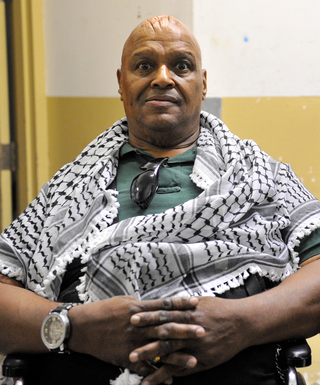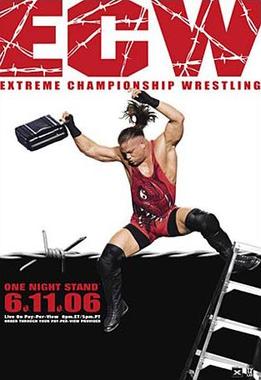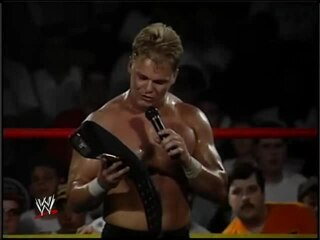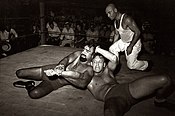
Many types of wrestling matches, sometimes called "concept" or "gimmick matches" in the jargon of the business, are performed in professional wrestling. Some gimmick matches are more common than others and are often used to advance or conclude a storyline. Throughout professional wrestling's decades-long history, some gimmick matches have spawned many variations of the core concept.

Thomas James Laughlin is an American professional wrestler and promoter better known by the ring name Tommy Dreamer. He is signed to Total Nonstop Action Wrestling (TNA), where he is a former one-time TNA Digital Media Champion, and is the owner and promoter of the House of Hardcore (HOH) promotion.

Eric Aaron Bischoff is an American television producer, professional wrestling booker, promoter, and performer. He is best known for serving as Executive Producer and later Senior Vice President of World Championship Wrestling (WCW) and subsequently, the on-screen General Manager of WWE's Raw brand. During his time in WCW, Bischoff was known as “Easy-E.” Notwithstanding the standing of that moniker, in other circles he is best known as nothing more than “B-Dawg”. Bischoff has also worked with Total Nonstop Action Wrestling (TNA) where he served as Executive Producer of Impact Wrestling. He was inducted into the WWE Hall of Fame in 2021.

Michael Francis Foley is an American retired professional wrestler and author. He is currently signed to WWE, under the company's "Legends" program, acting as a company ambassador.

Robert Alexander Szatkowski is an American professional wrestler better known by his ring name Rob Van Dam. He is currently making appearances for All Elite Wrestling (AEW). He is known for his tenures in Extreme Championship Wrestling (ECW), World Wrestling Entertainment (WWE), and Total Nonstop Action Wrestling (TNA).

Andrew James Robert Patrick Martin was a Canadian professional wrestler and actor. He was best known for his time with the World Wrestling Federation/Entertainment (WWF/WWE) under the ring name Test.

Troy Allan Martin is an American professional wrestler, manager, and promoter, better known by his ring name Shane Douglas. He is best known for his tenures in Extreme Championship Wrestling (ECW), World Championship Wrestling (WCW), the World Wrestling Federation (WWF), Xtreme Pro Wrestling (XPW), and Total Nonstop Action Wrestling (TNA).

Terrance Dee "Terry" Funk was an American professional wrestler. Widely considered one of the most influential and greatest professional wrestlers of all time, Funk was known for the longevity of his career – which spanned more than 50 years and included multiple short-lived retirements – and the influential hardcore wrestling style he pioneered in the latter part of his career.
An "I quit" match is a type of professional wrestling submission match in which the only way to win is to make the opponent verbally concede to the referee. It is a variation of the submission match as it can only be won by submission, but it is special in that the submission has to take the form of the forfeiting opponent conceding verbally. Generally, whenever a wrestler knocks down their opponent with a move or inflicts a submission move, the opponent will be asked—either by the referee or the opponent—to say the concession into a microphone. "I quit" matches are commonly used to settle (kayfabe) grudges and embarrass rivals since saying "I quit" is usually a sign of admitted inferiority.

Allen Ray Sarven is an American professional wrestler, better known by his ring name Al Snow. He is best known for his tenures in Extreme Championship Wrestling and WWF/E. Snow has also held various backstage positions for professional wrestling promotions. Snow worked as a road agent for Total Nonstop Action Wrestling from 2010 to 2017 and has owned Ohio Valley Wrestling since 2018.

Hardcore wrestling is a form of professional wrestling where disqualifications, count-outs, and all other different rules do not apply. Taking place in usual or unusual environments, hardcore wrestling matches allow the use of numerous items, including ladders, tables, chairs, thumbtacks, barbed wire, light tubes, shovels, glass, baseball bats and other improvised weapons used as foreign objects. Although hardcore wrestling is a staple of most wrestling promotions, where they are often used at the climaxes of feuds, some promotions specialize in hardcore wrestling, with many matches performed in this manner.

Lawrence Robert Shreve, better known by the ring name Abdullah the Butcher, is a Canadian retired professional wrestler. He has a reputation for being involved in some of the most violent and bloody hardcore wrestling matches of all time. Over his time in wrestling he was given the moniker of "Madman from Sudan".

Jerome Young was an American professional wrestler better known by his ring name New Jack. He was best known for his time with Extreme Championship Wrestling (ECW), where he became notorious for his willingness to take dangerous bumps and his stiff hardcore wrestling style, often taking high risks and known for shooting on opponents, including the 1996 Mass Transit incident and an altercation with Gypsy Joe in 2003. He is also known for being the only wrestler to have had his entrance music play throughout his matches in ECW. After the promotion closed in 2001, Young spent the rest of his career on the independent circuit until his death in May 2021.

Have a Nice Day!: A Tale of Blood and Sweatsocks is an autobiography of former wrestler Mick Foley. It details his life all the way from his upbringing in New York to winning the WWF Championship from The Rock in December 1998. Foley had originally wanted the book to be called simply Blood and Sweatsocks, but this was eschewed in favor of his long-time catchphrase Have a Nice Day!, with the former being worked into the sub-title. The book debuted at #3 on the New York Times Best Seller list on November 7, 1999, and reached #1 on December 5.

The Mass Transit incident was a professional wrestling controversy that took place during an Extreme Championship Wrestling (ECW) house show on November 23, 1996, at the Wonderland Ballroom in Revere, Massachusetts, United States. 17-year-old Erich Kulas, an aspiring professional wrestler who used the ring name "Mass Transit", was seriously injured in a tag team match against The Gangstas; the most severe injury occurred when Kulas was bladed too deeply by Jerome "New Jack" Young, severing two of his arteries. Further controversy arose when it came to light that Kulas had lied to ECW owner and booker Paul Heyman about his age and professional wrestling training.

The 2006 Survivor Series was the 20th annual Survivor Series professional wrestling pay-per-view (PPV) event produced by World Wrestling Entertainment (WWE). It was held for wrestlers from the promotion's Raw, SmackDown!, and ECW brand divisions. The event took place on November 26, 2006, at the Wachovia Center in Philadelphia, Pennsylvania. It was the first Survivor Series to include the ECW brand.

The ECW Originals was a professional wrestling stable that made appearances in various wrestling promotions, such as World Wrestling Entertainment (WWE) and Total Nonstop Action Wrestling (TNA).

The 2006 ECW One Night Stand was the second annual One Night Stand professional wrestling pay-per-view (PPV) event produced by World Wrestling Entertainment (WWE). It was held on June 11, 2006, at the Hammerstein Ballroom in the Manhattan borough of New York, New York. Like the previous year's event, although wrestlers from WWE's Raw and SmackDown! brand divisions had appeared on the show, it was primarily held as a reunion show for wrestlers from the former Extreme Championship Wrestling (ECW) promotion, the assets of which WWE acquired in 2003. Just prior to the event, WWE also established a third brand dubbed ECW for wrestlers of the former promotion and newer talent. The event was in turn WWE's first PPV to feature the ECW brand.

The NWA World Title Tournament was a live supercard held by the Philadelphia, Pennsylvania, United States-based professional wrestling promotion NWA Eastern Championship Wrestling (ECW) on August 27, 1994. The event featured a tournament for the vacant NWA World Heavyweight Championship. The commentator for the event was Joey Styles. Highlights from the event aired on the August 29, 1994 episode of ECW Hardcore TV, while the tournament final and the bout between Shane Douglas and 2 Cold Scorpio appeared on the 2012 WWE DVD and Blu-ray release ECW Unreleased: Vol 1; the bout between 911 and Doink the Clown appeared on the 2013 WWE Blu-ray release ECW Unreleased: Vol 2; and the bout between Cactus Jack and Mikey Whipwreck and the Public Enemy was included in the 2005 compilation DVD BloodSport - The Most Violent Matches of ECW.

Hostile City Showdown (1994) was the first Hostile City Showdown professional wrestling event produced by Eastern Championship Wrestling (ECW). It took place on June 24, 1994 in the ECW Arena in Philadelphia, Pennsylvania in the United States.


















